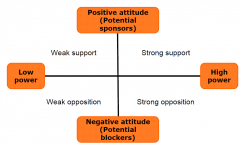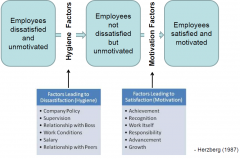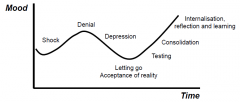![]()
![]()
![]()
Use LEFT and RIGHT arrow keys to navigate between flashcards;
Use UP and DOWN arrow keys to flip the card;
H to show hint;
A reads text to speech;
31 Cards in this Set
- Front
- Back
|
For what can network analysis be used? (3)
|
1) Gathering and interpreting information 2) Stakeholder management 3) Communication of change |
|
|
How can network representations of systems help a change manager/agent? (3)
|
a) Plan actions b) Prevent potential problems c) Identify important nodes |
|
|
Why is network representation important? |
Interaction matter, following a network perspective, change can be seen as a reorganisation of interaction patterns. |
|
|
Open systems theory predicts that...
|
...changes to any one of the elements of an organization’s subsystems can cause changes to the other elements
|
|
|
Which nodes is most important? (3)
|
1) Highest number of direct connections, a connector/hub
2) Strategic position between different parts of the network, can control what flows in the network (gatekeeper) 3) Shortest distance from all other network members, can monitor flow in the Network |
|
|
What is Relational and attribute data, and how/when can it be used in a network analysis context? |
Attribute data measure the presence or absence of an attribute or characteristic for a response variable on every single node Relational data is computer stored data in columns and rows |
|
|
The complexity (in MoC) arises from the.... |
..interconnectedness within and between systems, which makes difficult to anticipates the propagation and nature of the changes. |
|
|
Types of ties in a Network (8)
|
1) Energy 2) Information 3) Material 4) Friendships 5) Co-affiliation 6) Co-location 7) Spatical 8) Financial |
|
|
What is the difference between management and leadership?
|
Management - doing Things right.
Leadership is - doing the right things |
|
|
Describe the stakeholder grid (figure)
|

|
|
|
The motivation equation
|
Inputs from organisational members + Performance + outcome received by organisational members + -> members make an evaluation |
|
|
What is Herzberg’s Motivator-Hygiene Theory?
|

|
|
|
Expectancy theory of motivation
|

Expectancy theory cosiders how expectations influeces motivation. Attractiveness of outcome and likelyhood of outcome is to key factors. what i do help + the desired outcome is possible |
|
|
What is "The psychological contract"? |
Unwritten set of expectations, incorporating concepts such as fairness, trust and reciprocity Responses: If employer keeps side of the contract, commitment, motivation, effort, engagement is likely to come from employee |
|
|
Reasons why people would resist change (5)
|
1) Low trust, Bad experiences 2) Low tolerance for change, concerend that thay will not develop themselfs, difficult ot let go 4) Different assesments, of current situation and what is neccessery 5) Parochial self interest, personal loss of value, not in my interest |
|
|
Whays to minimise resistance (7)
|
1) Education and persuasion, rational arguments and technical evidence. appealing to emotions (advertising) 2) Involvement in collection, analysis and presantation of information 3) Facilitate and support, often useful if the recictance is due to fear. Training, giving time off or emotional support. 4) Negotiation, rewarding behaviors that facilitates the change 5) Manipulation and co-option (give reward to only leader) 6) Explicit and implicit coercion (forcing, must be used when you cannot Allure) 7) Goal setting |
|
|
The stages of psychological reaction |

|
|
|
What is the key leadership tasks when leading change (7) |
1) Sense making 2) Visioning 3) Sense giving 4) Aligning 5) Enabeling 6) Supporting 7) Maintaining momentum and sustaining change |
|
|
1) Sense making, definition and Oticon example |
Identify the opportunities and threats. Oticon: Lars Kollind made customer satisfaction and market research |
|
|
2) Visioning |
Find vision and more desireble state, and what actions have to be done Oticon: Think the unthinkable & project 330, Dawn visioned a more structured Oticon |
|
|
3) Sense giving |
Communicationg the vision and responding to feed back Oticon: this was missing in the Dawn project. Lars Kollind did by holding the open meeting 18. april (stay in Copenhagen) |
|
|
4) Aligning |
Promoting a shared sence of direction so that people can work together Oticon: Lars Killing the W strategy (people in focus) defined user and customer at separate later: SYNC WEEKS |
|
|
5) Enabeling |
Removing obstacles and creating conditions that empower others to implement the change Oticon: old buildings and locations replaced by new building |
|
|
6) Supporting |
Recognising and respondig to concerns of those affected by the change Oticon: Lars Kollind Copenhagen area, data training and hope computers |
|
|
7) Maintaining the momentum and supporting the change |
Showing commitment and walking the talk to keep people focused on the change Lars Kollind: Did the same as the rest of the employees. And also invested in the company |
|
|
Five communication strategies: |
2) Tell and sell 3) Underscore and explore 4) Identify and reply 5) Withold and uphold |
|
|
Spray and pray |
Towering people with information in the hope that they will feel informed and make improved decision making. Assume people are able to find the information valuable to them |
|
|
Tell and sell |
Communication limited set of messages believed related to the core issue and to the change. Often well planed Oticon: 18. april meeting |
|
|
Underscore and explore |
Focusing the attention on a limited set of information. Listening actively for potential misunderstandings and unrecognised obstacles |
|
|
Identify and reply |
Main focus - the organisational members concerns. Listening to identify and respond to concerns. Oticon: Daylight and the 22-half-day meetings |
|
|
Withhold and uphold |
Withholding information until necessary. Share information on a need-to-know basis. Information is power, and the organisational members will not understand anyway. Oticon: Dawn, six-people decided on the change, and presented the decision. |

